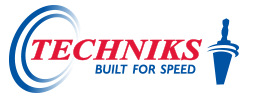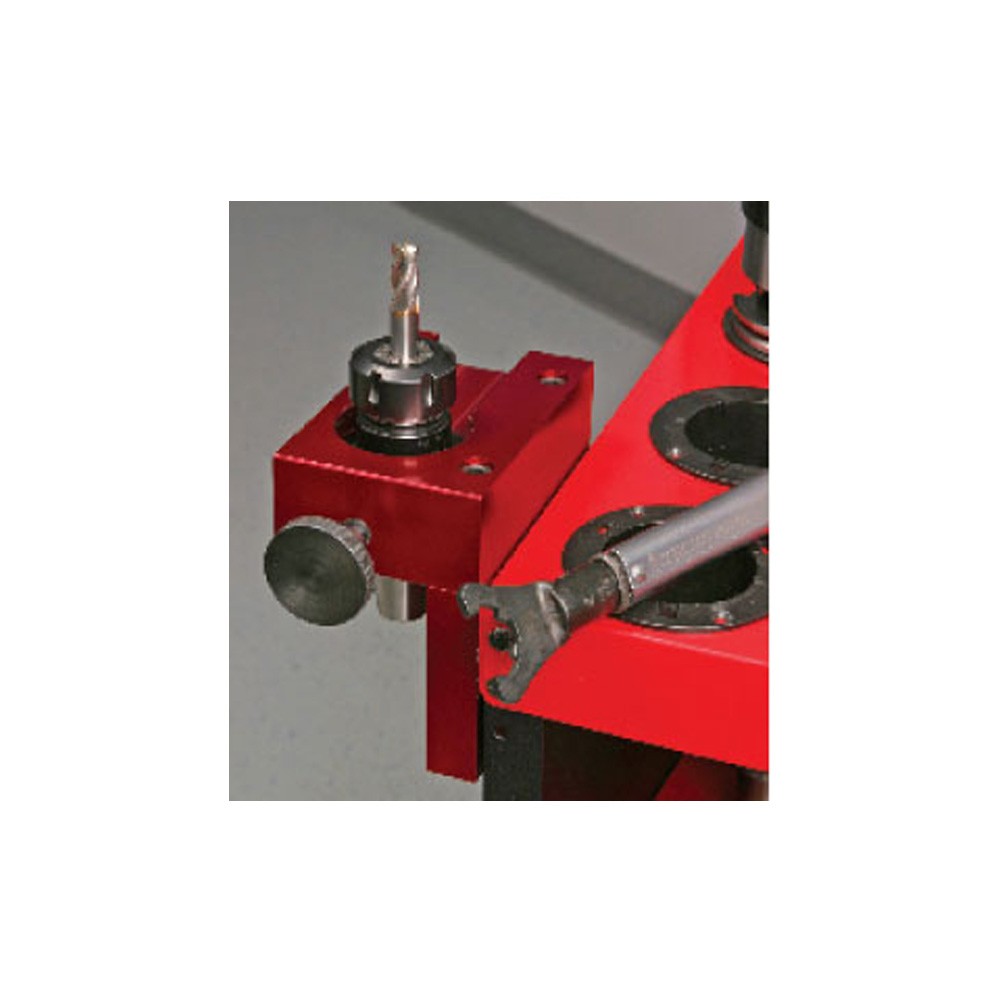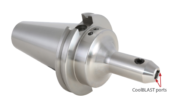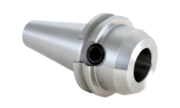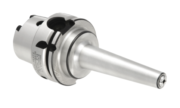Description
Torque Specifications
We recommend using a tightening fixture and torque wrench to make sure cutting tools and retention knobs are properly tightened. Over-tightening can distort or even crack collets, causing runout problems and premature failure of the collet, nut, tool holder and cutting tool. Under-tightening can also cause poor cutting performance, or allow cutting tools to fly out of the spindle – a very serious safety hazard.
-
Snap collet into nut
-
Insert cutter into collet. Collets without counter bore require shank to extend to the bottom of the collet.
-
Hand tighten collet nut assembly into tool holder.
-
Insert tool holder assembly into tightening fixture and secure it.
-
Tighten collet nut to recommended torque using a torque wrench and adapter.
The Importance of Proper Torque in a Collet Chuck Tool Holding System – Techniks CNC Tooling Solutions
This article discusses on the importance of proper torque when setting up a collet chuck tool holder and how using a torque wrench helps ensures consistency across tool changes. Please go to the bottom for a torque specifications guise or click to Download Full Torque Specifications Chart in a PDF version.
What is Torque?
Torque is a measure of the force that causes an object to rotate around an axis. Torque varies in magnitude based on the distance from the pivot point. This is why wrenches designed to apply higher torque values have longer handles than wrenches designed to apply smaller torque values. However, as we shall see, tighter is not always better. What is critical for consistent and optimal performance from collet chucks is applying the proper torque to the collet nuts and retention knobs (if the holder utilizes retention knobs) with each tool setup and tool change.
Torque is measured in Foot-Pounds (ft-lb) or Newton Meters (Nm). The higher the number the more twisting force is delivered.
Collet Nut Torque
Let’s dig in to understand what occurs and the various forces that come into play when tightening the collet nut in a collet chuck tool holding system and how proper torque helps create a more accurate holding system. For proper collet chuck tool holder assembly, first snap the collet into the collet nut ensuring the extraction groove in the collet seats with the extraction ring in the collet nut. Next, place the collet & collet nut assembly into the collet pocket of the tool holder body and begin tightening the collet nut. You will probably notice the collet tends to turn with the collet nut for the first few rotations. However, as soon as the taper of the collet contacts the walls of the collet pocket the collet no longer rotates with the collet nut. However, the collet nut must continue to be tightened to achieve the proper torque value. As the collet nut is tightened, the face of the collet that contacts the collet nut is subjected to friction from this mating surface while the taper of the collet is fixed in the collet pocket. The result is a torsional force on the collet – twisting the top of the collet while the bottom is held in place. This is often referred to radial distortion since the roundness of the collet is being compromised. Radial distortion affects the accuracy of the collet chuck assembly, reducing tool life. Therefore, it is important to apply the proper amount of torque to the collet nut to achieve adequate holding power on the tool shank while avoiding unnecessary torsional forces from over-tightening the collet nut.
When tightening a collet nut with a hand wrench, the operator has no way of knowing what amount of torque is being applied to the collet nut. In the absence of a torque wrench and to avoid under-tightening the collet nut that could create a safety issue, operators often feel compelled to use a cheater bar or wrench handle extension to apply more torque to the nut than is possible using just the hand wrench alone. However, as we just explained, over-tightening collet nuts creates issues with the accuracy of the collet chuck assembly. In order to achieve the correct amount of torque to ensure adequate holding power on the tool shank and avoid unnecessary torsional forces on the collet, it is necessary to use a torque wrench.
Retention Knob Torque
Equally important as applying proper torque to the collet nut for optimal performance of a collet chuck tool holder assembly, so too is applying proper torque to the retention knob. The retention knob is an often-overlooked component when it comes to the collet chuck assembly. However, failing to apply proper torque specifications when tightening the retention knob can lead to a number of issues.
The retention knob is the all-important component of a tool holding system that is held and drawn into the machine spindle by the machine’s drawbar. The retention knob is subjected to many cycles of high pulling forces by the drawbar. Many operators apply the same rationale when tightening the retention knob as they do when tightening the collet nut – if tight is good, tighter is better. However, as we shall see, over-tightening retention knobs can lead to several issues including reduced cutting tool life, rough surface finishes, damage to the tool holder taper, damage to the machine’s spindle, and even retention knob breakage that can create a safety issue
To understand the issues created from over-tightening retention knobs, we must first understand the forces between the retention knob threads and the threads in the tool holder body. As the retention knob is tightened, its threads exert a pulling force on the threads in the tool holder. This force is what holds the retention knob in the tool holder body. However, if too much torque is applied to the retention knob, the pulling force can distort or swell the exterior taper of the tool holder body at top of the taper. This swelling may prevent the tool holder taper from achieving maximum contact with the machine. For the best rigidity, it is important to maximize the contact are between the machine spindle and of the tool holder taper. If the top of the taper is swollen due to over-tightening, this area will contact the spindle but the lower section of the taper closer to the gage line of the tool holder taper may not achieve full contact with the spindle. The result is excessive vibration that reduces tool life and can lead to unacceptable surface finishes. Further, the vibration at the gage line of the tool holder taper will produce a phenomenon called fretting that shows up as rust-colored lines or patches on the tool holder taper. This is not rust, but, rather, areas where the vibration has created excessive heat creating small “welds” between the tool holder taper and the machine spindle. Continued use of tool holders with swollen tapers due to retention knob over-tightening will affect the performance of the tool. Additionally, machine spindles that have been subjected to holding fretted holders will also pass this issue on to other holders as they are used in the spindle.
As with tightening collet nuts, in the absence of a torque wrench operators are faced with the dilemma of either over-tightening the retention knob or under-tightening that can lead to catastrophic failure if the retention knob separates from the tool holder while in operation. Using a torque wrench ensures the proper torque is used to securely hold the retention knob in the tool holder body while avoiding taper swelling.
Torque Wrench
A torque wrench is a tool that guarantees repeatable torque is applied to the collet nut and retention knobs. Many torque wrenches are adjustable and have a range of torque values that they can deliver. Most torque wrenches have a clutching mechanism and click when the desired torque value is achieved.
Torque Specifications for Collets
Techniks Collet Chucks are designed to deliver excellent performance in a wide range of machining applications including milling, drilling, and tapping.
Our exclusive PowerCOAT nuts come standard on all ER and TG Collet Chuck providing 75% more holding power on the tool shank vs. standard collet nuts for improved safety and reduce the potential of tool slippage. Both through-spindle and CoolFLEX AD+B flange coolant delivery are available.
COLLET | NUT TYPE | COLLETS I.D. OVER 1/16″ (2MM) | COLLETS I.D. UNDER 1/16″ (2MM) | ORDER TORQUE WRENCH ADAPTER |
ER 16 | slotted | 42 ft/lbs | 30 ft/lbs | 04580-16 |
ER 16 | hex | 42 ft/lbs | 30 ft/lbs | 04601-16 |
ER 20 | slotted | 59 ft/lbs | 24 ft/lbs | 04580-20 |
ER 20 | hex | 59 ft/lbs | 24 ft/lbs | 04602-20 |
ER 25 | slotted | 77 ft/lbs | 77 ft/lbs | 04503-25 |
ER 25 | mini nut | 25 ft/lbs | 25 ft/lbs | 4587 |
ER 32 | slotted | 100 ft/lbs | 100 ft/lbs | 04604-32 |
ER 40 | slotted | 130 ft/lbs | 130 ft/lbs | 04605-40 |
SYOZ 25 | hook | 90 ft/lbs | 90 ft/lbs | 03690-25 |
TG 75 | hook | 90 ft/lbs | 90 ft/lbs | 04018-TWA |
TG 100 | hook | 90 ft/lbs | 90 ft/lbs | 03690-25 |
CAT Retention Knobs are manufactured from aircraft-quality AMS-6274 alloy steel and are hardened for maximum longevity.
Use the manufacturer’s print that came with your machine to verify your selection. For safe operation, ensure the pull stud you order is the exact pull stud your machine uses. Using the wrong pull stud can cause damage to the spindle and/or tool holder, and can create a safety hazard.
RETENTION KNOBS | WRENCH FLATS | DRIVE | TORQUE | ORDER SOCKET |
BT 30 Taper | 0.535″ | 1/4″ | 22 ft/lbs | PSS-30BT |
ISO 30 Taper | 0.535″ | 3/8″ | 22 ft/lbs | PSS-30ISO |
Any 40 Taper | 0.750″ | 3/8″ | 32 ft/lbs | PSS-40 |
BT 50 Taper | 1.187″ | 1/2″ | 62 ft/lbs | PSS-50 |
CAT 50 Taper | 1.250″ | 1/2″ | 62 ft/lbs | PSSC-50 |
CAT 40 End Mill Holders are manufactured to meet or exceed the H5 specification. H5 is an extremely accurate bore I.D. and provides improved T.I.R. for extended cutting tool life.
When machining in tight areas makes sure to try our Rigid Reach End Mill holders. Its tapered design makes its body more rigid, which is extremely important when milling at extended lengths. For dual contact spindles, Techniks DualDRIVE end mill holders provide increased rigidity and accuracy during heavy side loads.
PART NO. | DESCRIPTION | TORQUE |
22907 | CAT40x1/8×2.375 | 4 ft/lbs |
22907-5.00-RR | CAT40x1/8xRR | 4 ft/lbs |
22907-6 | CAT40x1/8×6 | 4 ft/lbs |
22909 | CAT40x3/16×2.5 | 6 ft/lbs |
22909-4.72-RR | CAT40x3/16xRR | 6 ft/lbs |
22909-6 | CAT40x3/16×6 | 6 ft/lbs |
22911 | CAT40x1/4×3 | 6 ft/lbs |
22911-1.75 | CAT40x1/4×1.75 | 6 ft/lbs |
22911-2.5 | CAT40x1/4×2.5 | 6 ft/lbs |
22911-2.5-FID | CAT40x1/4xFID | 6 ft/lbs |
22911-4.72-RR | CAT40x1/4xRR | 6 ft/lbs |
22911-6 | CAT40x1/4×6 | 6 ft/lbs |
22911-DIN | CAT40x1/4xDIN | 6 ft/lbs |
22913 | CAT40x5/16×3 | 10 ft/lbs |
22913-2.5 | CAT40x5/16×2.5 | 10 ft/lbs |
22913-4.72-RR | CAT40x5/16xRR | 10 ft/lbs |
22915 | CAT40x3/8×3 | 15 ft/lbs |
22915-1.75 | CAT40x3/8×1.75 | 10 ft/lbs |
22915-2.5 | CAT40x3/8×2.5 | 15 ft/lbs |
22915-2.5-FID | CAT40x3/8xFID | 15 ft/lbs |
22915-4.72-RR | CAT40x3/8xRR | 15 ft/lbs |
22915-5 | CAT40x3/8×5 | 15 ft/lbs |
22915-DIN | CAT40x3/8xDIN | 15 ft/lbs |
22916 | CAT40x7/16×2.5 | 20 ft/lbs |
22917 | CAT40x1/2×3 | 20 ft/lbs |
22917-1.75 | CAT40x1/2×1.75 | 20 ft/lbs |
22917-2.5 | CAT40x1/2×2.5 | 20 ft/lbs |
22917-2.5-FID | CAT40x1/2xFID | 20 ft/lbs |
22917-2.63 | CAT40x1/2×2.63 | 20 ft/lbs |
22917-4.72-RR | CAT40x1/2xRR | 20 ft/lbs |
22917-DIN | CAT40x1/2xDIN | 20 ft/lbs |
22918 | CAT40x1/2×4.63 | 20 ft/lbs |
22919 | CAT40x5/8×3 | 35 ft/lbs |
22919-1.75 | CAT40x5/8×1.75 | 35 ft/lbs |
22919-DIN | CAT40x5/8xDIN | 35 ft/lbs |
22920 | CAT40x5/8×3.75 | 35 ft/lbs |
22920-5.75 | CAT40x5/8×5.75 | 35 ft/lbs |
22921 | CAT40x3/4×3.5 | 45 ft/lbs |
22921-1.75 | CAT40x3/4×1.75 | 45 ft/lbs |
22921-3 | CAT40x3/4×3 | 45 ft/lbs |
22921-3-DIN | CAT40x3/4xDIN | 45 ft/lbs |
22921-3-FID | CAT40x3/4xFID | 45 ft/lbs |
22921-5 | CAT40x3/4×5 | 45 ft/lbs |
22923 | CAT40x7/8×3.5 | 45 ft/lbs |
22925 | CAT40x1x4 | 70 ft/lbs |
22925-1.75 | CAT40x1x1.75 | 45 ft/lbs |
22925-6 | CAT40x1x6 | 70 ft/lbs |
22925-DIN | CAT40x1xDIN | 70 ft/lbs |
22925-FID | CAT40x1xFID | 70 ft/lbs |
22927 | CAT40x1-1/4×4.6 | 70 ft/lbs |
22929 | CAT40x1-1/2×4.5 | 70 ft/lbs |
CAT50 End Mill Holders are manufactured to meet or exceed the H5 specification. H5 is an extremely accurate bore I.D. and provides improved T.I.R. for extended cutting tool life.
When machining in tight areas makes sure to try our Rigid Reach End Mill holders. Its tapered design makes its body more rigid, which is extremely important when milling at extended lengths. For dual contact spindles, Techniks DualDRIVE end mill holders provide increased rigidity and accuracy during heavy side loads.
PART NO. | DESCRIPTION | TORQUE |
22931 | CAT50x1/4×4 | 6 ft/lbs |
22931-2 1/2 | CAT50x1/4×2-1/2 | 6 ft/lbs |
22933 | CAT50x5/16×4 | 10 ft/lbs |
22935 | CAT50x3/8×4 | 15 ft/lbs |
22935-2 1/2 | CAT50x3/8×2-1/2 | 15 ft/lbs |
22935-6 | CAT50x3/8×6 | 15 ft/lbs |
22935-DIN | CAT50x3/8xDIN | 15 ft/lbs |
22936-8 | CAT50x3/8×8 | 15 ft/lbs |
22937 | CAT50x1/2×4 | 20 ft/lbs |
22937-2 5/8 | CAT50x1/2×2-5/8 | 20 ft/lbs |
22937-6 | CAT50x1/2×6 | 20 ft/lbs |
22937-8 | CAT50x1/2×8 | 20 ft/lbs |
22937-DIN | CAT50x1/2xDIN | 20 ft/lbs |
22939 | CAT50x5/8×4 | 35 ft/lbs |
22939-1.44 | CAT50x5/8×1.44 | 35 ft/lbs |
22939-3 | CAT50x5/8×3 | 35 ft/lbs |
22939-6 | CAT50x5/8×6 | 35 ft/lbs |
22939-8 | CAT50x5/8×8 | 35 ft/lbs |
22941 | CAT50x3/4×4 | 45 ft/lbs |
22941-1.44 | CAT50x3/4×1.44 | 45 ft/lbs |
22941-3 | CAT50x3/4×3 | 45 ft/lbs |
22941-5.75 | CAT50x3/4×5.75 | 45 ft/lbs |
22941-6 | CAT50x3/4×6 | 45 ft/lbs |
22941-8 | CAT50x3/4×8 | 45 ft/lbs |
22941-DIN | CAT50x3/4xDIN | 45 ft/lbs |
22943 | CAT50x7/8×4 | 45 ft/lbs |
22945 | CAT50x1x4 | 70 ft/lbs |
22945-2.62 | CAT50x1x2.62 | 70 ft/lbs |
22945-6 | CAT50x1x6 | 70 ft/lbs |
22945-DIN | CAT50x1xDIN | 70 ft/lbs |
22946-8 | CAT50x1x8 | 70 ft/lbs |
22947 | CAT50x1-1/4×4.6 | 70 ft/lbs |
22947-2.62 | CAT50x1-1/4×2.62 | 70 ft/lbs |
22947-6 | CAT50x1-1/4×6 | 70 ft/lbs |
22947-8 | CAT50x1-1/4×8 | 70 ft/lbs |
22947-DIN | CAT50x1-1/4xDIN | 70 ft/lbs |
22949 | CAT50x1-1/2×4.6 | 70 ft/lbs |
22949-2 | CAT50x1-1/2×2 | 70 ft/lbs |
22949-DIN | CAT50x1-1/2xDIN | 70 ft/lbs |
22951 | CAT50x2x6 | 125 ft/lbs |
BT End Mill Holders are manufactured to meet or exceed the H5 specification. H5 is an extremely accurate bore I.D. and provides improved T.I.R. for extended cutting tool life.
When machining in tight areas makes sure to try our Rigid Reach End Mill holders. Its tapered design makes its body more rigid, which is extremely important when milling at extended lengths. For dual contact spindles, Techniks DualDRIVE end mill holders provide increased rigidity and accuracy during heavy side loads.
BT 30 End Mill Holders
PART NO. | DESCRIPTION | TORQUE |
07130-1/8 | BT30x1/8 | 4 ft/lbs |
07130-3/16 | BT30x3/16 | 6 ft/lbs |
07130-1/4 | BT30x1/4 | 6 ft/lbs |
07130-5/16 | BT30x5/16 | 10 ft/lbs |
07130-3/8 | BT30x3/8 | 15 ft/lbs |
07130-7/16 | BT30X7/16 | 20 ft/lbs |
07130-1/2 | BT30x1/2 | 20 ft/lbs |
07130-5/8 | BT30x5/8 | 35 ft/lbs |
07130-3/4 | BT30x3/4 | 45 ft/lbs |
BT 40 End Mill Holders
| PART NO. | DESCRIPTION | TORQUE |
07140-1/8 | BT40x1/8 | 4 ft/lbs |
07140-3/16 | BT40x3/16 | 6 ft/lbs |
07140-1/4 | BT40x1/4 | 6 ft/lbs |
07140-5/16 | BT40x5/16 | 10 ft/lbs |
07140-3/8 | BT40x3/8 | 15 ft/lbs |
07140-1/2 | BT40x1/2 | 20 ft/lbs |
07140-5/8 | BT40x5/8 | 35 ft/lbs |
07140-3/4 | BT40x3/4 | 45 ft/lbs |
07140-1 | BT40x1 | 70 ft/lbs |
07140-1 1/4 | BT40x1-1/4 | 70 ft/lbs |
07140-1 1/2 | BT40x1-1/2 | 70 ft/lbs |
BT 50 End Mill Holders
PART NO. | DESCRIPTION | TORQUE |
07150-1/4 | BT50x1/4 | 6 ft/lbs |
07150-3/8 | BT50x3/8 | 15 ft/lbs |
07150-1/2 | BT50x1/2 | 20 ft/lbs |
07150-5/8 | BT50x5/8 | 35 ft/lbs |
07150-3/4 | BT50x3/4 | 45 ft/lbs |
07150-1 | BT50x1 | 70 ft/lbs |
07150-1-6 | BT50x1x6 | 70 ft/lbs |
07150-1-1/4 | BT50x1-1/4 | 70 ft/lbs |
Techniks Milling Chucks provide up to 5X the gripping force of other manufacturers’ ER40 holders to meet the most demanding, high material removals rates applications such as heavy milling of titanium or other high-temp alloys. The nut is designed to sit flush against the flange when properly tightened preventing damage to the bearing assembly from over-tightening.
A machined bearing cage and high precision, individually matched needle bearings symmetrically placed provide smooth, reliable operation. All Techniks Milling Chucks are designed with CoolBLAST coolant grooves in the I.D. bore to direct coolant to the cutting area and assist with chip evacuation. Coolant discs can be used to seal around the tool shank for coolant-through cutting tools. Reduction sleeves can be used to hold almost any shank diameter.
PART NO. | DESCRIPTION | TORQUE |
23241 | CAT40 3/4″ – 3.62″ | 45 ft/lbs |
23242 | CAT40 3/4″ – 4.13″ | 45 ft/lbs |
23246 | CAT40 1 1/4″ – 4.52″ | 45 ft/lbs |
23252 | CAT50 3/4″ – 4.13″ | 45 ft/lbs |
23256 | CAT50 1 1/4″ – 4.13″ | 45 ft/lbs |
05990 | BT40 3/4″ – 3.15″ | 45 ft/lbs |
05991 | BT40 1 1/4″ – 3.54″ | 45 ft/lbs |



